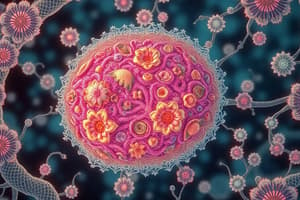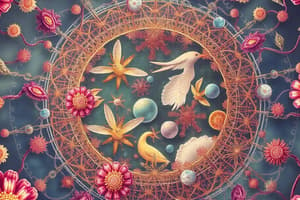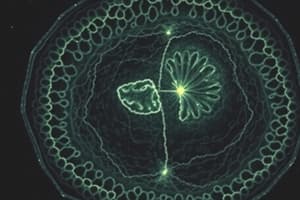Podcast
Questions and Answers
What is the primary function of meiosis in cell biology?
What is the primary function of meiosis in cell biology?
- To transport substances across cell membranes
- To produce identical daughter cells for growth
- To reduce the chromosome number for sexual reproduction (correct)
- To convert light energy into chemical energy
Which of the following processes does not require energy input?
Which of the following processes does not require energy input?
- Osmosis of water molecules (correct)
- Endocytosis of large particles
- Active transport of glucose molecules
- Sodium-potassium pump operation
Which stage of cellular respiration occurs in the mitochondrial matrix?
Which stage of cellular respiration occurs in the mitochondrial matrix?
- Electron Transport Chain
- Glycolysis
- Photosynthesis
- Krebs Cycle (correct)
What role do receptors play in signal transduction?
What role do receptors play in signal transduction?
What is the main purpose of cell differentiation?
What is the main purpose of cell differentiation?
What is a fundamental component of the cell theory?
What is a fundamental component of the cell theory?
Which statement accurately describes eukaryotic cells?
Which statement accurately describes eukaryotic cells?
Which organelle is responsible for producing ATP?
Which organelle is responsible for producing ATP?
What is the primary function of ribosomes within a cell?
What is the primary function of ribosomes within a cell?
During which phase of mitosis do the sister chromatids separate and move to opposite poles of the cell?
During which phase of mitosis do the sister chromatids separate and move to opposite poles of the cell?
Flashcards are hidden until you start studying
Study Notes
Cell Biology
Basic Cell Concepts
- Cell Definition: Basic unit of life, comprising all living organisms.
- Cell Theory:
- All living things are made of cells.
- The cell is the basic unit of structure and function.
- All cells arise from pre-existing cells.
Types of Cells
- Prokaryotic Cells:
- Lack a nucleus and membrane-bound organelles.
- Examples: Bacteria and Archaea.
- Eukaryotic Cells:
- Contain a nucleus and membrane-bound organelles.
- Examples: Plant cells, animal cells, fungi, and protists.
Cell Structure
-
Cell Membrane:
- Phospholipid bilayer that regulates entry and exit of substances.
- Contains proteins, cholesterol, and carbohydrates.
-
Nucleus:
- Contains genetic material (DNA).
- Surrounded by the nuclear envelope.
-
Cytoplasm:
- Gel-like substance where cellular processes occur.
- Contains organelles and cytosol.
Organelles
-
Mitochondria:
- Powerhouse of the cell, site of ATP production.
- Involved in cellular respiration.
-
Ribosomes:
- Sites of protein synthesis.
- Can be free in the cytoplasm or attached to the endoplasmic reticulum.
-
Endoplasmic Reticulum (ER):
- Rough ER: Studded with ribosomes; involved in protein synthesis and modification.
- Smooth ER: Lacks ribosomes; involved in lipid synthesis and detoxification.
-
Golgi Apparatus:
- Modifies, sorts, and packages proteins and lipids for transport.
-
Lysosomes:
- Contain digestive enzymes for breaking down waste and cellular debris.
-
Chloroplasts (in plant cells):
- Site of photosynthesis; contain chlorophyll.
-
Cell Wall (in plant cells):
- Rigid structure providing support and protection, made of cellulose.
Cell Division
-
Mitosis:
- Process of somatic cell division resulting in two identical daughter cells.
- Phases: Prophase, Metaphase, Anaphase, Telophase, and Cytokinesis.
-
Meiosis:
- Process of gamete formation resulting in four genetically diverse cells.
- Involves two rounds of division: Meiosis I and Meiosis II.
Cellular Processes
-
Cellular Respiration:
- Process of converting glucose and oxygen into ATP, carbon dioxide, and water.
- Stages: Glycolysis, Krebs Cycle, and Electron Transport Chain.
-
Photosynthesis (in plants):
- Process of converting light energy into chemical energy in the form of glucose.
- Occurs in chloroplasts; involves light-dependent and light-independent reactions.
Cell Communication
- Signal Transduction:
- Process by which cells respond to external signals (hormones, neurotransmitters).
- Involves receptors, signaling molecules, and cascades leading to cellular responses.
Cell Transport Mechanisms
-
Passive Transport:
- Movement of substances across the membrane without energy input.
- Includes diffusion, osmosis, and facilitated diffusion.
-
Active Transport:
- Movement of substances against their concentration gradient, requiring energy (ATP).
- Involves transport proteins (e.g., sodium-potassium pump).
-
Endocytosis and Exocytosis:
- Endocytosis: Process of taking in materials by engulfing them in a membrane.
- Exocytosis: Process of expelling materials from the cell via vesicles.
Key Concepts
- Homeostasis: Cells maintain a stable internal environment despite external changes.
- Cell Differentiation: Process through which cells become specialized for specific functions.
Basic Cell Concepts
- Cells are the fundamental units of life in all living organisms.
- Cell theory encompasses three primary principles:
- All living things are comprised of cells.
- Cells serve as the basic structural and functional units.
- All cells originate from pre-existing cells.
Types of Cells
- Prokaryotic Cells:
- Lack a true nucleus and membrane-bound organelles.
- Examples include bacteria and archaea.
- Eukaryotic Cells:
- Possess a nucleus and membrane-bound organelles.
- Include plant cells, animal cells, fungi, and protists.
Cell Structure
- Cell Membrane:
- Consists of a phospholipid bilayer that controls the movement of substances in and out.
- Contains proteins, cholesterol, and carbohydrates integrated within.
- Nucleus:
- Houses genetic material (DNA) and is enclosed by the nuclear envelope.
- Cytoplasm:
- A gel-like matrix where metabolic processes occur, consisting of organelles and cytosol.
Organelles
- Mitochondria:
- Known as the cell's powerhouse; crucial for ATP production and cellular respiration.
- Ribosomes:
- Sites for protein synthesis, existing freely in the cytoplasm or attached to the endoplasmic reticulum.
- Endoplasmic Reticulum (ER):
- Rough ER has ribosomes and is involved in protein synthesis and modification.
- Smooth ER lacks ribosomes and focuses on lipid synthesis and detoxification processes.
- Golgi Apparatus:
- Responsible for modifying, sorting, and packaging proteins and lipids for cellular transport.
- Lysosomes:
- Contain digestive enzymes essential for breaking down waste products and cellular debris.
- Chloroplasts (found in plant cells):
- Sites for photosynthesis and contain chlorophyll, enabling energy conversion.
- Cell Wall (found in plant cells):
- Provides structural support and protection; composed of cellulose.
Cell Division
- Mitosis:
- Involves somatic cell division resulting in two identical daughter cells through phases: Prophase, Metaphase, Anaphase, Telophase, and Cytokinesis.
- Meiosis:
- Creates gametes, resulting in four genetically unique cells, involving two stages of division: Meiosis I and Meiosis II.
Cellular Processes
- Cellular Respiration:
- Converts glucose and oxygen into ATP, carbon dioxide, and water across three stages: Glycolysis, Krebs Cycle, and Electron Transport Chain.
- Photosynthesis (occurs in plants):
- Transforms light energy into chemical energy stored as glucose, involving light-dependent and light-independent reactions.
Cell Communication
- Signal Transduction:
- Mechanism by which cells interpret and respond to external signals like hormones and neurotransmitters, involving receptors and cellular responses.
Cell Transport Mechanisms
- Passive Transport:
- Encompasses movement across the membrane without energy use, including diffusion, osmosis, and facilitated diffusion.
- Active Transport:
- Requires energy to move substances against their concentration gradient, utilizing transport proteins such as the sodium-potassium pump.
- Endocytosis and Exocytosis:
- Endocytosis is the process of membrane engulfing to take in materials.
- Exocytosis involves the expulsion of materials from the cell using vesicles.
Key Concepts
- Homeostasis:
- Cells maintain a consistent internal environment despite fluctuations in the external environment.
- Cell Differentiation:
- The process whereby cells specialize to perform unique functions within an organism.
Studying That Suits You
Use AI to generate personalized quizzes and flashcards to suit your learning preferences.




